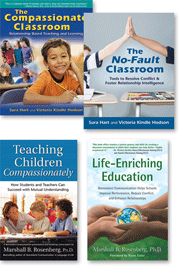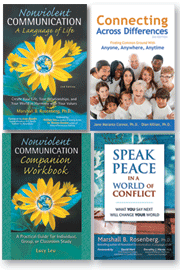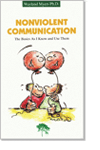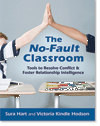Group Agreements that Work, continued
Provocative because in every training there are teachers who argue that they’ve tried Group Agreements and they don’t work. However, when we inquire further, we find that what they have tried is significantly different from what we recommend.
With a new school year starting, we’re eager to share this dynamic process with you, too.
1. Group Agreements serve a Classroom Vision created by students and teacher.
Rules imposed by adults often seem arbitrary to kids. Group Agreements, however, have a specific purpose: to support the kind of classroom everyone wants.
Before making Group Agreements, brainstorm with students what kind of a classroom they want: How do they want to be treated? How do they want the classroom to function? After your brainstorm, make a collage, poem or document that represents the classroom you want to co-create.
2. Group Agreements are made by the people who are affected by them.
Unlike school and teacher-created rules, Group Agreements are created by everyone who is affected by them. In a classroom this means the teacher and the students. It is a foundational practice for sharing power, giving young people the confidence that they matter, and their input is important.
3. Group Agreements take place in an ongoing conversation about things that matter to everyone.
The most common misunderstanding about Group Agreements is that they can be made in a few sessions at the beginning of the year, and they are to be obeyed after that. Think about it: we are talking about how we want to live together for an entire school year, and beyond -- how we want to live, period.
And, many young people don’t even have have models for how to live with others with care for all. Yet, teachers routinely expect kids to sign off early in the school year on global rules such as “Be Respectful” or “Be Honest.”
Discussing throughout the year what we mean by Honesty, Respect, Trust, Acceptance, Inclusion, Kindness, and what we can DO to fulfill needs for them can become the most exciting and meaningful core curriculum for the school year, and provide life-long skills for learning and living with others.
4. Group Agreements are a living document.
The Group Agreements we’re talking about are not static rules set in stone, made once and for all. They are open to questioning, evaluating, refining, and changing. The guiding question is: Are the Agreements we made helping us to live our values and fulfill the vision we have for our classroom? If not, what new strategy can we try?
5. Group Agreement conversations lead to specific, actions that students and teachers can DO to demonstrate and live their values.
When agreements and rules don’t work it’s often because they include things that are not do-able, such as: “Be” Respectful; “Be” Honest; and “Be” Trustworthy.
These statements sound good, but they set up a vague and unrealistic expectation that someone can BE a value. And they don’t give clear direction for what people can DO to live according to their values.
Group Agreements that work take the values held in common and translate them into do-able actions. See Step #5 below.
1. Briefly discuss the two kinds of Safety: 1) physical safety and 2) emotional safety. What is physical safety? Emotional safety?
Briefly discuss what happens when we feel unsafe physically or emotionally (including when we fear criticism, blame, or negative judgments). The frontal, learning lobes of the brain shut down and we prepare to protect ourselves by fighting, fleeing, or freezing in our tracks. See The No-Fault Classroom, p. 25.
2. Ask the Question, Who doesn’t want to feel physically safe at school? This question can initiate additional meaningful conversation about Physical Safety.
3. Make a “Physical Safety” chart. Every school has safety rules, and you may also have things you want people to do in your classroom for safety reasons, eg., Walk, don’t run. Start with these established “rules” and ask if anyone is not clear about their purpose. Then, ask if anyone has other suggestions for making the classroom physically safe.
4. Discuss the importance of Emotional Safety. Initiate this conversation with similar questions: Who does not want to feel emotionally safe? Emotional Safety is the #1 requirement for learning to take place. Do you agree? What does emotional safety look like? See The No-Fault Classroom, p. 25.
Write students’ responses on two charts: Chart 1: write what they say about actions that do not contribute to emotional safety (eg, name-calling, laughing at mistakes.) Chart 2, titled “Our Values”, write the positive values that emerge in conversation: Honesty, Respect, Acceptance.
5. Making Agreements Do-able: From BE to DO. On a new piece of chart paper, make two columns with the following headings: BE and DO.
List values under BE and actions under DO. For example, Honesty is in the “BE” column. Under the “DO” column, on the right, brainstorm do-able actions that demonstrate Honesty, e.g. Talk directly to the person instead of behind their back; Use “I” statements; Say what matters to you; Ask for what you want. Then write the next value in the BE column and do-able actions for it in the DO column, etc.
6. Start agreement at the beginning of the year, and add to it. When you take time to discuss do-able actions throughout the year you:
- Communicate that student input is appreciated and contributes
- Raise awareness about skills to develop to better live values
- Support a group intention to find and practice useful skills
7. Check in with Group Agreements every day for the first weeks, then at least once a week. Ask, “How are these agreements working for us?” Celebrate what’s working. Take a look at what’s not and adjust: try new strategies.
As new skills develop, add them to the “DO” list. Some people say that conversations like this take too much time from the school curriculum. Yet teachers who do Group Agreements in this way say that they result in NOT having to take time later “managing” student disruptions.
Conclusion: If you’d like more support for Group Agreements, read The No-Fault Classroom (Hart & Kindle Hodson) or contact us for training, coaching or consulting at www.thenofaultzone.com. 1088 Note: These guidelines for Group Agreements work as well in homes, businesses, and other communities.
Sura Hart and Victoria Kindle Hodson are co-authors of The Compassionate Classroom, Respectful Parents, Respectful Kids, and The No-Fault Classroom, as well as creators of The No-Fault Game. They bring a combined 45 years of elementary teaching and parent education experience to their work. As co-founders of Kindle-Hart Communication, they’ve been developing and facilitating parent and teacher education workshops together for over 20 years.
Keep learning these vital communication skills with these books and training resources:
This Month's Specials:
- NVC Educator Book Package - Save 50% off list price through September 30, 2010
- NVC Starter Kit Book Package - Save 60% off list price through August 30, 2010
Every Day Specials:
- The Compassionate Classroom - Save 30% on this book every day from PuddleDancer Press
- The No-Fault Classroom - Save 30% on this book every day from PuddleDancer Press
- Life Enriching Education - Save 30% on this book every day from PuddleDancer Press
- Teaching Children Compassionately - Save 30% on this booklet every day from PuddleDancer Press
- NVC Marshall Rosenberg Package - Save 45% on this book package every day from PuddleDancer Press
- NVC Reference Library Package - Save 50% on this book package every day from PuddleDancer Press









